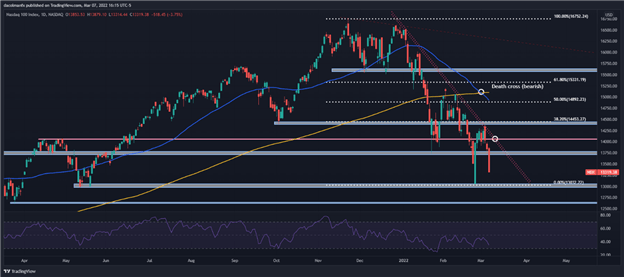Nasdaq 100 Plunges Into Bear Market As Oil Price Surge Kindles Stagflation Worries
Last week brought nothing but turmoil to Wall Street. Although the February jobs report released on Friday was undeniably strong and encouraging thanks in part to the rapid decline in COVID-19 cases, investors took little comfort in the data, as the ongoing crisis in Eastern Europe occupied everyone's mind.
At the start of this week, the situation is no better, in fact, the mood is rapidly souring with stocks down across the board. In this context, the Nasdaq 100 plummeted 3.75% to 13,319 on Monday amid heavy selling activity in the tech sector, posting its biggest drop since early last month and plunging into bear market, a situation in which the underlying asset has fallen 20% or more from a recent high.
Russia's invasion of Ukraine has triggered a huge rally in the commodities space, especially oil, as the forceful sanctions imposed on Moscow for its aggression have increased the geopolitical risk premium and begun to disrupt some global trade. Against this backdrop, WTI and Brent have risen by approximately 25% in March alone and are trading at their highest level since 2008. While it is not yet time to panic, it is important to understand that current events are likely to accelerate inflationary pressures and weigh on economic activityvia the sentiment channel and through demand destruction stemming from higher raw material costs.
In general, high inflation coupled with weak GDP growth is a bad combination for equities and, of course, a perfect recipe for volatility, but the problem increases exponentially if prevailing macroeconomic conditions lead to stagflation, an environment of surging consumer prices and flat or falling output that tends to be excessively detrimental to corporate profits.
At this time, the U.S. economy remains on good footing and looks set to expand above potential in 2022 (3.2%), according to most forecasts, but the outlook could quickly deteriorate if the war in Ukraine drags on and escalates into a broader regional confrontation involving NATO. It is not possible to know with certainty how the crisis will unfold, but traders should be prepared for all scenarios. On that note, it is important to point out that Kiev and Moscow concluded their third round of talks on Monday, but were unable to reach a truce/ceasefire agreement, with President Putin digging in and doubling down on his outrageous demands. For context, Putin wants Ukraine to demilitarize, modify its constitution to enshrine NATO neutrality, acknowledge Crimea as Russian territory, and recognize the separatist republics of Donetsk and Lugansk as independent states. These are all non-starter terms for Ukraine.
In any case, I still believe cooler heads will prevail and military hostilities will ease soon one way or another, so I remain cautiously bullish on equities in a medium-term horizon, especially as the conflict has prompted a dovish reassessment by central banks (Fed, ECB).
However, I also recognize that the situation is fluid, and that any miscalculation can exacerbate the crisis, so I’d shun high beta stocks in cyclical sectors and focus on quality and defensive plays for now, at least until the dust settles. At the same time, I’d be inclined to increase exposure to energy, metals and agricultural commodities given their constructive profile (USO, XOP, WEAT, DBB, DBA look attractive for tactical plays). The latter trade can perform well if current or new sanctions on Russia curtail its exports dramatically, exacerbating supply-demand imbalances for raw materials (Russia is a commodity powerhouse).
Turning our attention to the Nasdaq 100, the index has officially entered bear market as mentioned before. That said, the technical picture is not pretty for the tech benchmark, especially after the development of a death cross on the daily chart last week. With sentiment extremely fragile and elevated market volatility, dip buyers will be reluctant to step in to pick up risk assets despite depressed prices. This may leave the Nasdaq 100 in a precarious position and vulnerable to a retest of the 2022 low in the very near term.
However, it is important to underscore a critical point: if the military conflict in Eastern Europe de-escalates and sentiment improves, we may see a furious rally in the Nasdaq 100 considering how much it has fallen in 2022 and its oversold condition. In the event of a bullish reversal, resistance is seen at 13,750 and then at 14,000. If price manages to clear these hurdles, the next upside target appears around 14,453, the 38.2% Fibonacci retracement of the November 2021/February 2022 decline.
NASDAQ 100 TECHNICAL CHART

Disclosure: See the full disclosure for DailyFX here.



